代词等小结
- 格式:ppt
- 大小:101.50 KB
- 文档页数:11
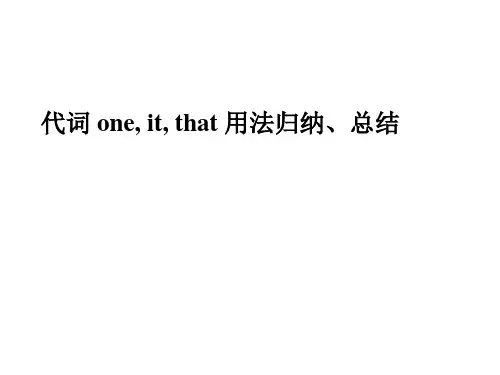
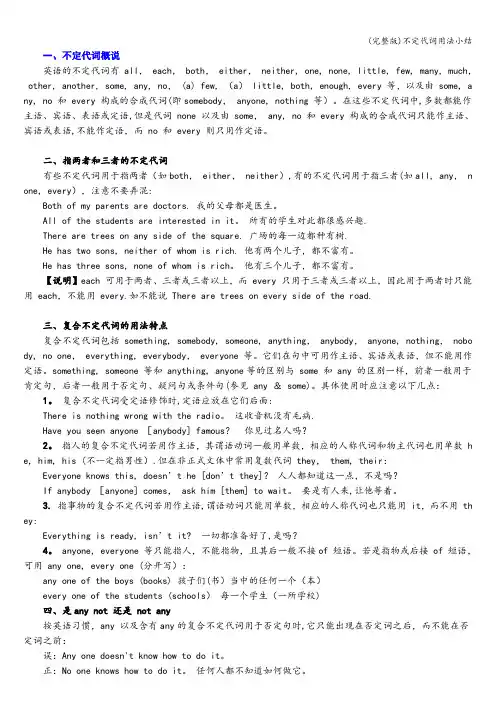
一、不定代词概说英语的不定代词有 all, each, both, either, neither, one, none, little, few, many, much, other, another, some, any, no, (a) few, (a) little, both, enough, every 等,以及由 some, a ny, no 和 every 构成的合成代词(即somebody, anyone, nothing 等)。
在这些不定代词中,多数都能作主语、宾语、表语或定语,但是代词 none 以及由 some, any, no 和 every 构成的合成代词只能作主语、宾语或表语,不能作定语,而 no 和 every 则只用作定语。
二、指两者和三者的不定代词有些不定代词用于指两者(如both, either, neither),有的不定代词用于指三者(如all, any, n one, every),注意不要弄混:Both of my parents are doctors. 我的父母都是医生。
All of the students are interested in it。
所有的学生对此都很感兴趣.There are trees on any side of the square. 广场的每一边都种有树.He has two sons, neither of whom is rich. 他有两个儿子,都不富有。
He has three sons, none of whom is rich。
他有三个儿子,都不富有。
【说明】each 可用于两者、三者或三者以上,而 every 只用于三者或三者以上,因此用于两者时只能用 each,不能用 every.如不能说 There are trees on every side of the road.三、复合不定代词的用法特点复合不定代词包括 something, somebody, someone, anything, anybody, anyone, nothing, nobo dy, no one, everything, everybody, everyone 等。
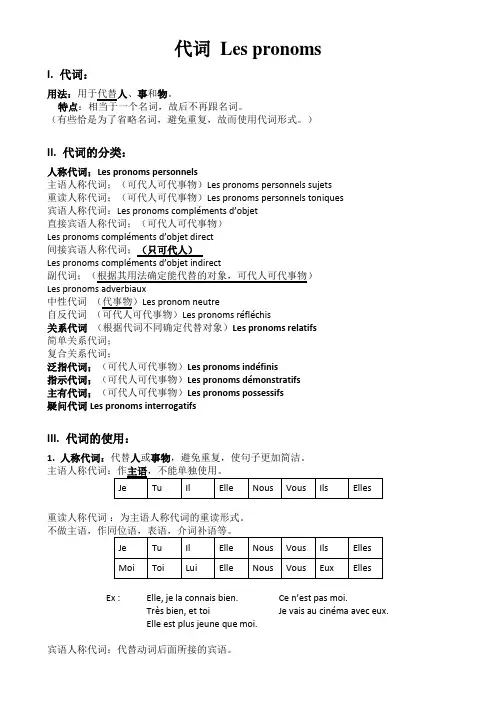
代词Les pronomsI. 代词:用法:用于代替人、事和物。
特点(有些恰是为了省略名词,避免重复,故而使用代词形式。
)II. 代词的分类:人称代词;Les pronoms personnels主语人称代词;(可代人可代事物)Les pronoms personnels sujets重读人称代词;(可代人可代事物)Les pronoms personnels toniques宾语人称代词:Les pronoms compléments d’obj et直接宾语人称代词;(可代人可代事物)Les pronoms compléments d’objet direct间接宾语人称代词;(只可代人)副代词;(根据其用法确定能代替的对象,可代人可代事物)中性代词(代事物)Les pronom neutre自反代词Les pronoms réfléchis关系代词(根据代词不同确定代替对象)Les pronoms relatifs简单关系代词;复合关系代词;泛指代词;(可代人可代事物)Les pronoms indéfinis指示代词;(可代人可代事物)Les pronoms démonstratifs主有代词;(可代人可代事物)Les pronoms possessifs疑问代词Les pronoms interrogatifsIII. 代词的使用:1. 人称代词:代替人或事物,避免重复,使句子更加简洁。
重读人称代词:为主语人称代词的重读形式。
不做主语,作同位语,表语,介词补语等。
Je Tu Il Elle Nous Vous Ils EllesMoi Toi Lui Elle Nous Vous Eux Elles Ex : Elle, je la connais bien.Ce n’est pas moi.Très bien, et toi Je vais au cinéma avec eux.Elle est plus jeune que moi.宾语人称代词:代替动词后面所接的宾语。
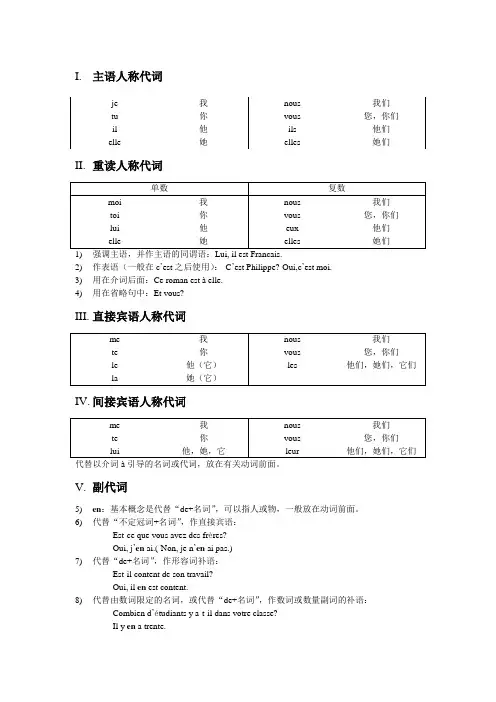
I. 主语人称代词II. 重读人称代词1) 强调主语,并作主语的同谓语:Lui, il est Francais. 2) 作表语(一般在c ’est 之后使用):-C ’est Philippe?-Oui,c’est moi. 3) 用在介词后面:Ce roman est à elle. 4)用在省略句中:Et vous?III. 直接宾语人称代词IV. 间接宾语人称代词代替以介词à引导的名词或代词,放在有关动词前面。
V. 副代词5) en :基本概念是代替“de+名词”,可以指人或物,一般放在动词前面。
6) 代替“不定冠词+名词”,作直接宾语:-Est-ce que vous avez des fr ères? -Oui, j ’en ai.(-Non, je n ’en ai pas.)7) 代替“de+名词”,作形容词补语:-Est-il content de son travail? -Oui, il en est content.8)代替由数词限定的名词,或代替“de+名词”,作数词或数量副词的补语:-Combien d ’étudiants y a-t-il dans votre classe? -Il y en a trente.9)与其他作间接宾语的人称代词同时使用,这时en要放在其他间接宾语人称代词的后面:-Je voudrais des pommes.-Vous en voulez combine?-Donnez-m’en trios kilos.10)代替“部分冠词+名词”-Vous prenez du thé?-Oui,j’en prends.(-Non, je n’en prends pas.)11)y:代替以à,dans等介词引导的地点状语,表示“这儿”,“那儿”,放在有关的动词前。
VI.指示代词VII.关系代词qui:在关系从句中一般作主语,既可指人,也可指物。
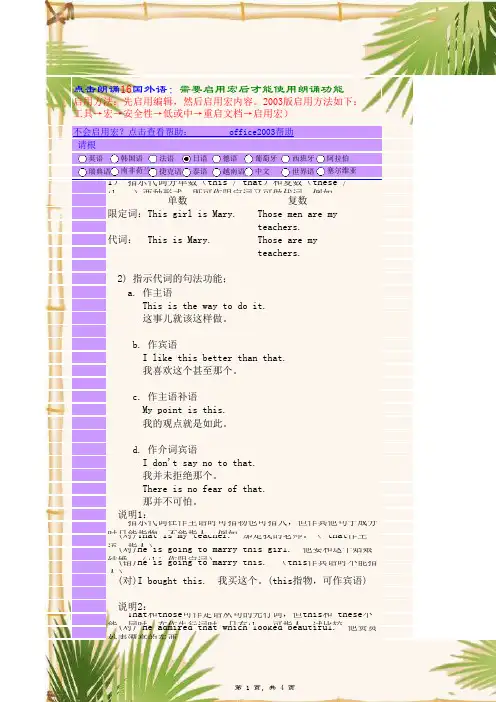
31353请根据内容ja 1) 指示代词分单数(this / that)和复数(these /those)两种形式,既可作限定词又可做代词,例如: 单数 复数限定词:This girl is Mary. Those men are my teachers.代词: This is Mary. Those are my teachers. 2) 指示代词的句法功能; a. 作主语 This is the way to do it. 这事儿就该这样做。
b. 作宾语 I like this better than that. 我喜欢这个甚至那个。
c. 作主语补语 My point is this. 我的观点就是如此。
d. 作介词宾语 I don't say no to that. 我并未拒绝那个。
There is no fear of that. 那并不可怕。
说明1: 指示代词在作主语时可指物也可指人,但作其他句子成分时只能指物,不能指人,例如: (对)That is my teacher. 那是我的老师。
( that作主语,指人) (对)He is going to marry this girl. 他要和这个姑娘结婚。
(this作限定词) (错)He is going to marry this. (this作宾语时不能指人) (对)I bought this. 我买这个。
(this指物,可作宾语) 说明2: That和those可作定语从句的先行词,但this和 these不能,同时,在作先行词时,只有those可指人,试比较: (对) He admired that which looked beautiful. 他赞赏外表漂亮的东西。
不会启用宏?点击查看帮助: office2003帮助点击朗诵16国外语:需要启用宏后才能使用朗诵功能启用方法:先启用编辑,然后启用宏内容。
2003版启用方法如下:工具→宏→安全性→低或中→重启文档→启用宏)英语韩国语法语日语德语葡萄牙西班牙阿拉伯瑞典语南非荷兰捷克语泰语越南语中文世界语塞尔维亚。
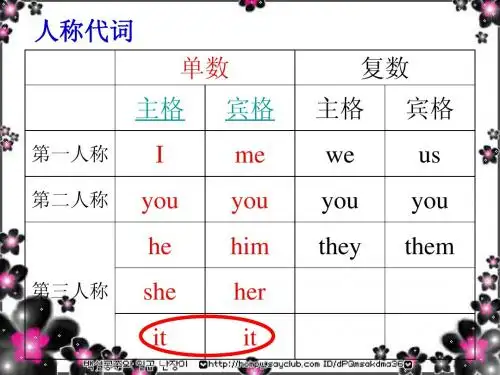
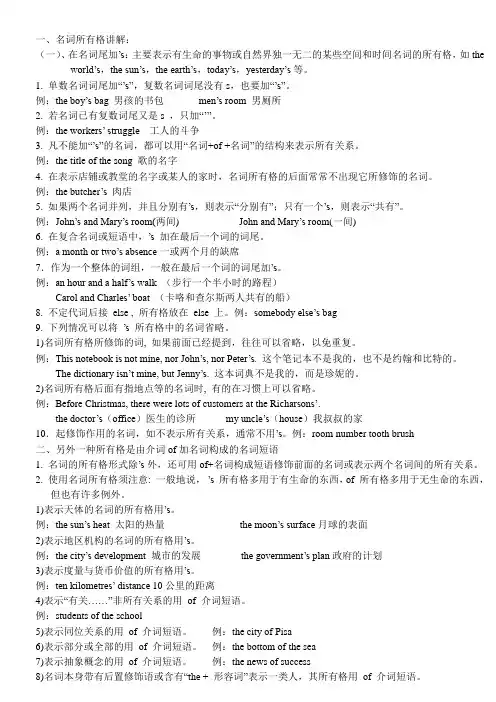
一、名词所有格讲解:(一)、在名词尾加’s:主要表示有生命的事物或自然界独一无二的某些空间和时间名词的所有格,如the world’s,the sun’s,the earth’s,today’s,yesterday’s等。
1. 单数名词词尾加―’s‖,复数名词词尾没有s,也要加―’s‖。
例:the boy’s bag 男孩的书包men’s room 男厕所2. 若名词已有复数词尾又是s ,只加―’‖。
例:the worke rs’ struggle工人的斗争3. 凡不能加―’s‖的名词,都可以用―名词+of +名词‖的结构来表示所有关系。
例:the title of the song 歌的名字4. 在表示店铺或教堂的名字或某人的家时,名词所有格的后面常常不出现它所修饰的名词。
例:the butcher’s 肉店5. 如果两个名词并列,并且分别有’s,则表示―分别有‖;只有一个’s,则表示―共有‖。
例:John’s and Mary’s room(两间) John and Mary’s roo m(一间)6. 在复合名词或短语中,’s 加在最后一个词的词尾。
例:a month or two’s absence一或两个月的缺席7.作为一个整体的词组,一般在最后一个词的词尾加’s。
例:an hour and a half’s walk (步行一个半小时的路程)Carol and Charles’ boat (卡咯和查尔斯两人共有的船)8. 不定代词后接else , 所有格放在else 上。
例:somebody else’s bag9. 下列情况可以将’s 所有格中的名词省略。
1)名词所有格所修饰的词, 如果前面已经提到,往往可以省略,以免重复。
例:This notebook is not mine, nor John’s, nor Peter’s. 这个笔记本不是我的,也不是约翰和比特的。
The dictionary isn’t mine, but Jenny’s. 这本词典不是我的,而是珍妮的。
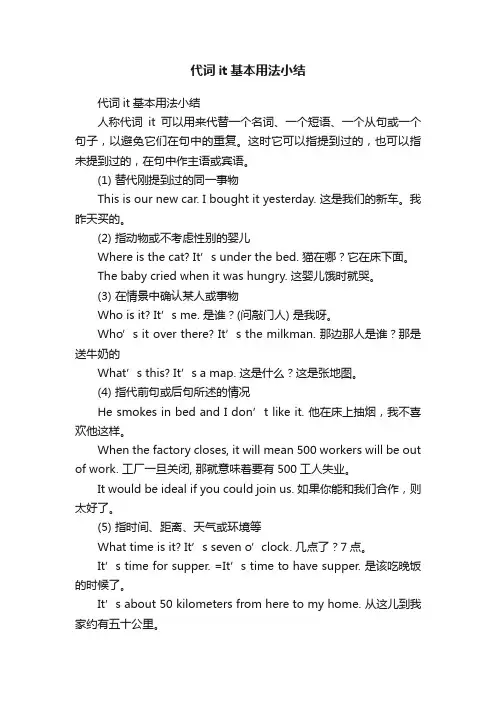
代词it基本用法小结代词it基本用法小结人称代词it可以用来代替一个名词、一个短语、一个从句或一个句子,以避免它们在句中的重复。
这时它可以指提到过的,也可以指未提到过的,在句中作主语或宾语。
(1) 替代刚提到过的同一事物This is our new car. I bought it yesterday. 这是我们的新车。
我昨天买的。
(2) 指动物或不考虑性别的婴儿Where is the cat? It’s under the bed. 猫在哪?它在床下面。
The baby cried when it was hungry. 这婴儿饿时就哭。
(3) 在情景中确认某人或事物Who is it? It’s me. 是谁?(问敲门人) 是我呀。
Who’s it over there? It’s the milkman. 那边那人是谁?那是送牛奶的What’s this? It’s a map. 这是什么?这是张地图。
(4) 指代前句或后句所述的情况He smokes in bed and I don’t like it. 他在床上抽烟,我不喜欢他这样。
When the factory closes, it will mean 500 workers will be out of work. 工厂一旦关闭, 那就意味着要有500工人失业。
It would be ideal if you could join us. 如果你能和我们合作,则太好了。
(5) 指时间、距离、天气或环境等What time is it? It’s seven o’clock. 几点了?7点。
It’s time for supper. =It’s time to have supper. 是该吃晚饭的时候了。
It’s about 50 kilometers from here to my home. 从这儿到我家约有五十公里。
It is snowing. 正在下雪It was very quiet in the garden. 公园里很寂静。
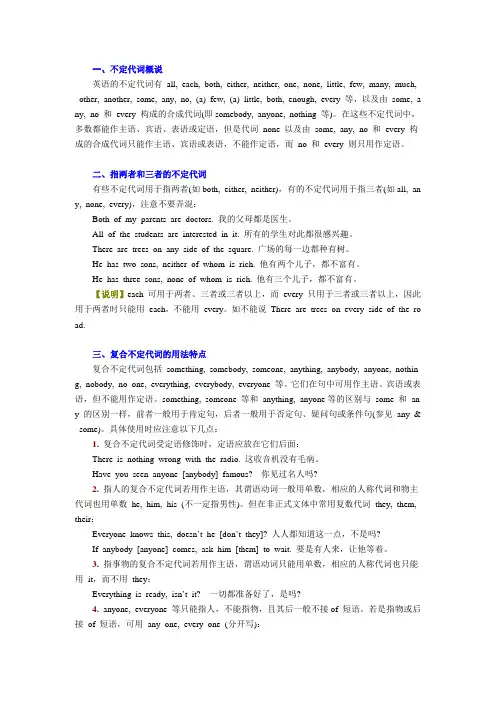
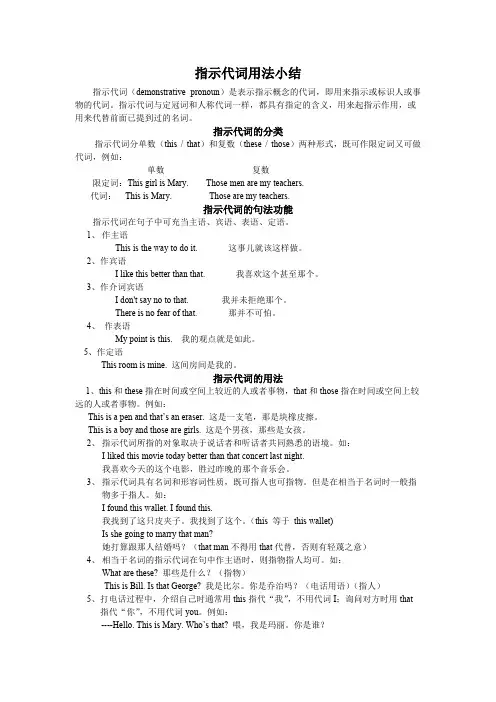
指示代词用法小结指示代词(demonstrative pronoun)是表示指示概念的代词,即用来指示或标识人或事物的代词。
指示代词与定冠词和人称代词一样,都具有指定的含义,用来起指示作用,或用来代替前面已提到过的名词。
指示代词的分类指示代词分单数(this / that)和复数(these / those)两种形式,既可作限定词又可做代词,例如: 单数 复数限定词:This girl is Mary. Those men are my teachers.代词: This is Mary. Those are my teachers.指示代词的句法功能 指示代词在句子中可充当主语、宾语、表语、定语。
1、作主语 This is the way to do it. 这事儿就该这样做。
2、作宾语 I like this better than that. 我喜欢这个甚至那个。
3、作介词宾语 I don't say no to that. 我并未拒绝那个。
There is no fear of that. 那并不可怕。
4、作表语 My point is this. 我的观点就是如此。
5、作定语This room is mine. 这间房间是我的。
指示代词的用法1、this和these指在时间或空间上较近的人或者事物,that和those指在时间或空间上较远的人或者事物。
例如:This is a pen and that’s an eraser. 这是一支笔,那是块橡皮擦。
This is a boy and those are girls. 这是个男孩,那些是女孩。
2、指示代词所指的对象取决于说话者和听话者共同熟悉的语境。
如:I liked this movie today better than that concert last night.我喜欢今天的这个电影,胜过昨晚的那个音乐会。
3、指示代词具有名词和形容词性质,既可指人也可指物。
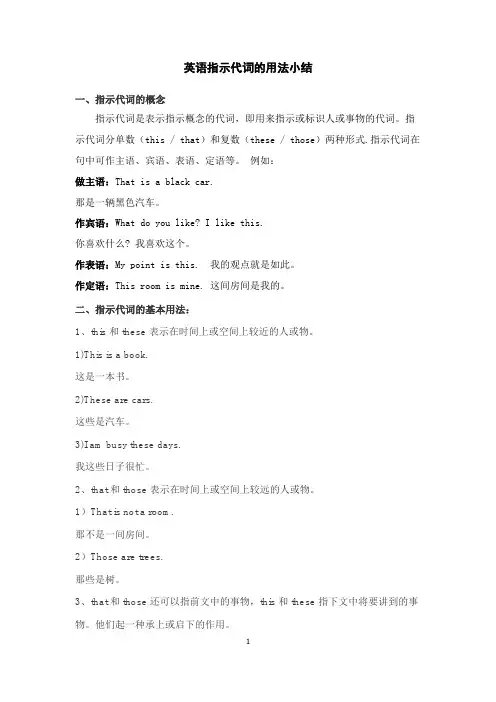
英语指示代词的用法小结一、指示代词的概念指示代词是表示指示概念的代词,即用来指示或标识人或事物的代词。
指示代词分单数(this / that)和复数(these / those)两种形式.指示代词在句中可作主语、宾语、表语、定语等。
例如:做主语:That is a black car.那是一辆黑色汽车。
作宾语:What do you like? I like this.你喜欢什么? 我喜欢这个。
作表语:My point is this. 我的观点就是如此。
作定语:This room is mine. 这间房间是我的。
二、指示代词的基本用法:1、this 和 these 表示在时间上或空间上较近的人或物。
1)This is a book.这是一本书。
2)These are cars.这些是汽车。
3)I am busy these days.我这些日子很忙。
2、that 和those 表示在时间上或空间上较远的人或物。
1)That is not a room.那不是一间房间。
2)Those are trees.那些是树。
3、that 和those 还可以指前文中的事物,this 和 these 指下文中将要讲到的事物。
他们起一种承上或启下的作用。
I got up late,that's why I missed the bus.我起床迟了,这就是为什么我没赶上汽车。
4、this和that是英语中两个最基本、最常用的指示代词,它们的区别是:1. 当涉及辨认近物和远物时用this和that加以区分,例如:This is a book. 这是一本书。
(指近处物品)That is a car. 那是一辆小汽车。
(指远处物品)What is that? 那是什么?(问远处物品)It is a jeep. 它是一辆吉普车。
5、介绍放在一起的两样东西时,先介绍的用this,后介绍的用that。
例如:This is a pen. That is a pencil. 这是一支钢笔,那是一支铅笔。
英语词汇语法用法小结1、人称代词主格作主语,宾格作宾语,形容词性物主代词修饰名词作定语,名词性物主代词作表语。
2、if 引导的条件状语从句:主将从现。
3、either…or/ neither…nor…及there be 句型采用就近原则。
3、过去的时间用过去的动作,过去的动作用动词的过去式。
4、动词+副词的短语,代词作宾语时放在中间。
5、形容词修饰不定代词时,放在不定代词之后---定语后置。
6、enough修饰名词时前置,修饰形容词时,状语后置。
7、表示虚拟语气时,系动词用were.8、关联词用because 不用so, 用though/although 不用but.9、分数表示法:基子序母,多子多母。
10、及物动词用语被动语态,不及物动词不可用于被动语态。
11、动词作主语时,动词改成动名词。
12、介词后面的动词改成动名词。
13、不定代词作主语时,谓语动词用单数。
14、形容词修饰名词、代词作定语,副词修饰形容词、动词作状语。
15、时间状语、地点状语、方式状语放在句子末尾。
16、make/keep+宾语+补语(形容词)。
17、一听、两看、一感觉、一使、一让、一帮助后面用动词原形。
18、一日三餐和球类运动前不用任何冠词。
19、江河湖海和乐器前加the。
20、表示一天的某时用in,表示某天的某时用on,表示几点几分用at,表示月、季、年用in。
21、a little, much, even, far, still 可修饰比较级。
22、one of + 最高级+ 名词复数。
23、两者比较用比较级,三者或三者以上比较用最高级。
24、单音节词的比较级加er,最高级加est,部分双音节词和多音节的比较级前加more, 最高级前加most。
25、两者比较强调一者时,比较级前也加the。
26、附加疑问句:前肯后否,前否后肯。
27、表示客观存在、客观真理、自然现象时,用一般现在时。
28、感叹句中How修饰形容词、副词,What 修饰名词。
无论+疑问代词用法小结随着语言的不断发展,人们在表达思想和情感时常常会使用一些特定的词语或短语。
其中,"无论"是一个常见的表达方式,它通常与疑问代词连用,用来引导一个特定的问题或情况,并表示不论怎样,都是这样的。
在中文语法中,"无论+疑问代词"的用法非常灵活,可以用于多种场合,包括句子的主语、宾语或状语等部分。
在接下来的文章中,我们将就"无论+疑问代词"的用法做一个小结。
一、"无论+疑问代词"用于句子的主语1. 无论谁"无论谁"用于句子的主语时,表示不管是谁,都是这样的。
例如:无论谁来,我们都欢迎。
无论谁去,都要告诉我。
2. 无论何人"无论何人"也可以用于句子的主语,表示不论是哪个人,都是这样的。
例如:无论何人犯错,都要受到惩罚。
二、"无论+疑问代词"用于句子的宾语1. 无论什么"无论什么"常用于句子的宾语部分,表示不论是什么,都是这样的。
例如:无论什么问题,我们都可以一起解决。
2. 无论多少"无论多少"也可以用于句子的宾语,表示不论是多少,都是这样的。
例如:无论多少困难,我们都要坚持下去。
三、"无论+疑问代词"用于句子的状语1. 无论何时"无论何时"常用于句子的状语部分,表示不论是什么时候,都是这样的。
例如:无论何时需要帮助,我都会尽力帮忙。
2. 无论多么"无论多么"也可以用于句子的状语,表示不论是多么,都是这样的。
例如:无论多么困难,我们都要勇敢面对。
"无论+疑问代词"的用法非常灵活,可以用于句子的主语、宾语或状语部分,表示不论怎样,都是这样的。
掌握这一结构的用法,有助于我们更准确、地道地表达自己的意思,丰富语言表达的方式,是我们提高语言水平的重要途径之一。
物主代词用法小结1)形容性物主代词只做修饰语,不能单独使用,后面必须跟名词。
Eg: This is my pen.2)名词性物主代词相当于形容词性物主代词+名词。
只能单独使用。
Eg: This isn’t my pen,mine is on the desk人称代词用法小结1)分类2)用法1、主格人称代词放在句首作主语Eg: I’m a student.2、宾格人称代词放在动词或介词后面作宾语Eg: Excuse me.Eg: My mother often buys some gifts for me.3、在比较结构中,在as和than之后跟人称代词的主格或宾格Eg: Lucy is taller than me/I.Eg: Lucy is as tall as me/I.4、作表语时常用人称代词的宾格Eg: -Who broke the door?-It’s me.5、几个人称代词同时出现,其排列顺序为:单数时:第二人称、第三人称、第一人称、(you、he\she、I)复数时:第一人称、第二人称、第三人称、(we、you、they)承担责任时,“I”在前Eg: -Who broke the window?-I and TomIt的用法1、it指人时的情况A、可指婴儿Eg: -What’s your baby doing?-It’s sleepingB、指不明确身份的人,尤指打电话的人和敲门人。
Eg: -Who talked with you on the phone just now?-It was Tom.C、指代图画或照片中的人Eg: -Who is the man in the picture?-It’s Yao Ming.。
英语代词小结Pronouns are an important part of the English language as they replace nouns in order to avoid repetition and make sentences more concise. They also help to clarify who or what is being referred to. Here is a summary of English pronouns:1. Personal Pronouns:- Subject pronouns: I, you, he, she, it, we, they- Object pronouns: me, you, him, her, it, us, them- Possessive adjectives: my, your, his, her, its, our, their- Possessive pronouns: mine, yours, his, hers, its, ours, theirs- Reflexive pronouns: myself, yourself, himself, herself, itself, ourselves, yourselves, themselves2. Demonstrative Pronouns:- This, that, these, thoseThese pronouns are used to point out specific people or things. 3. Interrogative Pronouns:- Who, whom, whose, which, whatThese pronouns are used to ask questions.4. Relative Pronouns:- Who, whom, whose, which, thatThese pronouns are used to start relative clauses that provide additional information about a noun or pronoun.5. Indefinite Pronouns:- Some, any, no, every, each, either, neither, all, noneThese pronouns refer to an indefinite or unknown person or thing.6. Reciprocal Pronouns:- Each other, one anotherThese pronouns are used to show mutual action or relationship between two or more people or things.7. Reflexive Pronouns:- Myself, yourself, himself, herself, itself, ourselves, yourselves, themselvesThese pronouns are used when the subject and the object of a sentence are the same.8. Relative Pronouns:- Who, whom, whose, which, thatThese pronouns are used to introduce a relative clause that provides additional information about a noun or pronoun.9. Possessive Pronouns:- Mine, yours, his, hers, its, ours, theirsThese pronouns show ownership or possession.10. Intensive Pronouns:- Myself, yourself, himself, herself, itself, ourselves, yourselves, themselvesThese pronouns are used to emphasize or intensify the subject of the sentence.It is essential to use the appropriate pronoun according to the grammatical rules and the context of the sentence. By usingpronouns correctly, we can improve our writing and communication skills in English.。
代词用法小结代词人称代词,物主代词,反身代词,指示代词,疑问代词,不定代词一.人称代词:单数主格复数宾格I 主格宾格第一人称第二人称第三人称 me we us you you you you it itthey them 1.主格作主语,宾格作表语或动词或介词的宾语.He teaches _____(we) Chinese ./ I’m waiting for you.(介词的宾语) / It’s me.(宾格做表语) 2.三种人称代词并列充当主语时时,顺序为:单数:(二,三,一)——(You, she and I )复数:(一,二,三)——(we , you and they ) 注::若把责任担,第一人称最当先,(即若做错事时,把第一人称放在最前面.) eg: She and I have been to Beijing .(一般情况) Who broke the window ? I and Mike .(承担责任)注:it 还有一些特别的用法。
1) 用在句型: “It seems that …”中.“看起来像。
….”2)用作形式主语,常用于“It’s +adj +to do sth”句型中.“做什么事情怎么样” . 3) 用在句型: “It’s one’s turn to do sth”中.“轮到某人做sth”4) 用在句型: “It’s time to do sth / for sth”中.“到了该做sth的时候” 5) 用在句型: “It’s +adj +that 从句”中.6) 用作形式宾语, 用来代替动词不定式.主语+make + it + adj (名词)+ to do sth . I find it difficult to remember these works.二.物主代词:物主代词分为形容词性物主代词和名词性物主代词第一人称物主代词形容词性第二人称单数第三人称单数复数单数复数复数my our your your its ours yoursyourstheir 名词性 mine its theirs1、形容词性物主代词作定语修饰名词,一般不单独使用.eg: My name is Tom.( 形容词性物主代词)2、名词性物主代词,后面不能加名词,名词性物主代词常与of 连用He is a friend of mine(我的一个朋友) eg:Our claroom is as big as ______(they) ./ This is a friend of ______(my).注: 1) 名词性物主代词=形容词性物主代词+ 名词(上题中mine=my friends) 2)形容词性物主代词与own 连用时,后面可跟名词也可不跟名词.My own house = a house of my own 三.反身代词:“某某自己;亲自” 单数复数myself ourselves yourself yourselves himself themselves 第一人称第二人称第三人称记忆小窍门: 反身代词有规律,第三人称宾格加self.其余都要物主加self,复数ves来把f 替.反身代词的常用搭配:enjoy oneself过得愉快 hurt oneself受伤 teach oneself = learn..by oneslf自学help oneself to …随便吃/用 look after oneself leave sb by oneself 让某人独自留下 dre oneself某人自己穿衣服 improve oneself提高某人自己四.指示代词单数复数 this that these those1、指示代词的用法: (1)this①指较近的事和人: This is my pen./ These are my books. ②指下文提到的事eg:P lease remember this:No pains,no gains.(2) that ①指较远的事和人: That is her sister./ Those are her sisters.②指上面刚提到的事情eg:He was ’s why he didn’t go to school.2.注意 that / those 常用来代替前面出现的人或物,以避免重复.That代替可数名词的单数或不可数名词.Those 代替复数名词.The weather in Guangdong is hotter than _____ in Qinghai .The books in that shop are cheaper than___in this .this 3.在电话用语中,this 代替自己,而that 代替对方.eg:This is Tom speaking .我是汤姆 Who is that ?你是谁?五、疑问代词:(P93考点五)用来提出问题的代词称为疑问代词,通常位于句首,引出特殊疑问句。